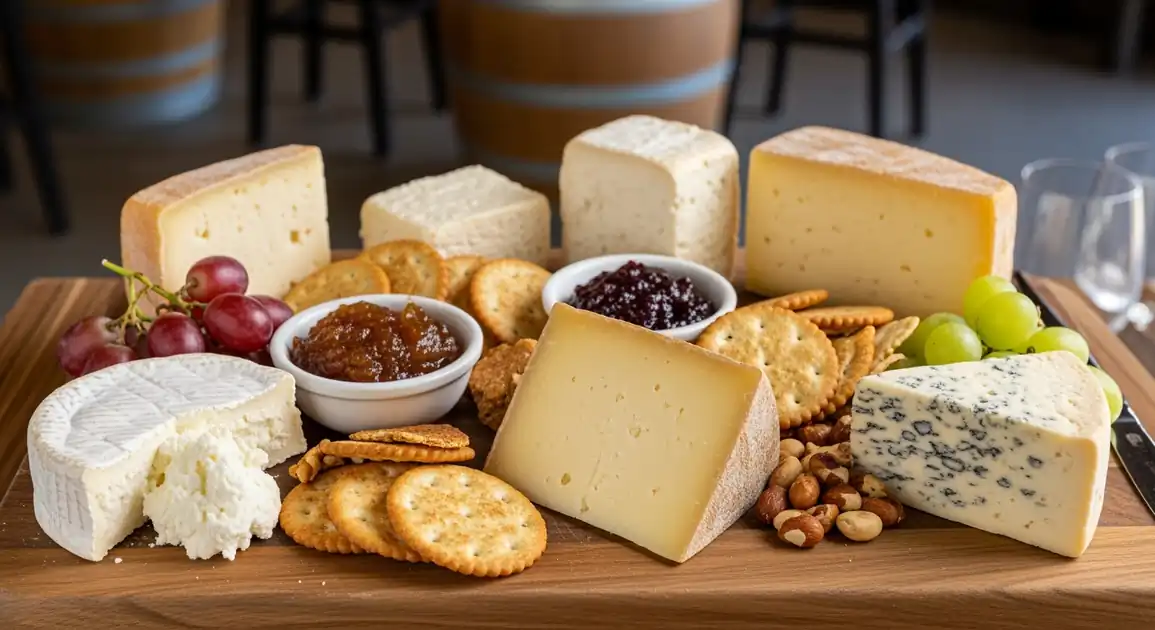Central Otago Cheese
Central Otago Cheese

Description
New Zealand has a thriving artisan cheese industry alongside its large-scale dairy production. High-quality cheeses are produced throughout the country, with regions like Central Otago, Canterbury, Waikato, and Northland known for distinct local producers. NZ cheese is widely available in supermarkets, specialty shops, and farmers markets.
Dietary Information
Serving information
Serving style
Commonly served on platters ('cheese boards') with crackers, fruit, nuts, and fruit pastes. Also sold by the wedge or block for home use.
Quick facts
Supermarkets: 8 AM - 9 PM/10 PM. Specialty shops: Typical retail hours (9 AM - 5 PM/6 PM). Markets: Specific weekend hours.
Safety Tips
What to Look For
-
Reputable branding and source
Choose cheese from known producers or reliable specialty shops/markets.
-
Proper packaging and storage
Ensure cheese is well-wrapped and refrigerated correctly at the point of sale.
-
Clear labeling (use-by date, pasteurization status)
Check dates for freshness and pasteurization info if required (especially for pregnant women or immunocompromised individuals).
-
Good condition
Cheese should look and smell appealing, without signs of excessive drying, sweating, or unwanted mold (unless it's a blue cheese).
What to avoid
-
Damaged or compromised packaging
Can indicate improper handling or potential contamination.
-
Cheese left unrefrigerated for extended periods
Increases risk of bacterial growth, especially for soft cheeses.
-
Visible mold (on non-blue cheeses)
Indicates spoilage. Small amounts on hard cheese rinds can sometimes be cut off, but caution is advised.
-
Signs of cross-contamination at deli counters
Ensure staff use clean knives and cutting surfaces between different cheeses.
Price information
Price range
Budget tips
- Supermarket deli selections often offer good value for quality NZ cheeses.
- Farmers markets allow direct purchase from producers, sometimes at better prices.
- Specialty imports will be significantly more expensive.
Value indicators
- Awards or medals (e.g., NZ Champions of Cheese Awards).
- Clear indication of milk type and cheesemaker.
- Good condition and aroma.
- Expert recommendations from cheesemongers.
Where to Find This Dish
Supermarkets
Most supermarkets have extensive deli sections with a wide range of NZ cheeses.
Pak'nSave, New World, Countdown
Store hours
Specialty Food Stores / Delis
Found in cities and larger towns, offering curated selections of local and imported cheeses.
Moore Wilson's (Wellington), Farro Fresh (Auckland), Specialty shops
Store hours
Farmers Markets
Excellent places to find local artisan cheesemakers selling directly.
Markets nationwide
Market days (often weekends)
Vendor Tips
- Explore different regions – NZ cheese offers diverse styles.
- Ask deli staff or cheesemongers for recommendations based on your preferences.
- Try pairing NZ cheeses with local wines, beers, or ciders.
How to Order
Regional Variations
-
Whitestone Cheese (Oamaru-based, widely available)
(Whitestone Cheese)
Though based just outside Central Otago, Whitestone Cheeses (Windsor Blue, Totara Tasty, Farmhouse) are very commonly found and representative of high-quality South Island cheese.
-
Gibbston Valley Cheese
(Gibbston Valley Cheese)
Producer located near Queenstown within the Gibbston wine region, offering various cow's milk cheeses often available at their cellar door and local shops.
-
Blue Cheese
(Blue Cheese)
Several local producers make blue cheeses, ranging from creamy and mild to pungent and strong.
-
Sheep/Goat Milk Cheese
(Sheep/Goat Milk Cheese)
Artisan cheeses made from sheep or goat milk, offering distinct tangy or earthy flavors, often from smaller local farms.
-
Soft Cheeses (Brie/Camembert Style)
(Soft Cheeses)
Creamy, bloomy-rind cheeses are popular, often made from cow's milk.
-
Hard/Semi-Hard Cheeses (Cheddar/Farmhouse Style)
(Hard/Semi-Hard Cheeses)
Includes various aged cheddars, Gruyere styles, or unique regional farmhouse cheeses.
Cultural context
History
While New Zealand has a long history of dairy farming and large-scale cheese production, the artisan cheese movement in regions like Central Otago is more recent, flourishing over the last few decades. Inspired by European traditions but utilizing local milk and terroir, cheesemakers began creating specialized, high-quality products. The synergy with the established wine industry has helped promote local cheese, often featured at cellar doors and regional food events.
Local significance
Growing appreciation for local artisan produce and paddock-to-plate philosophy. Cheese often features in entertaining and social gatherings.
Eating customs
- Served at room temperature.
- Often part of shared platters.